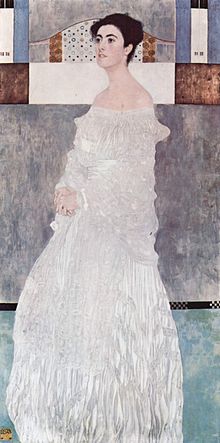Margaret Wittgenstein
| Margaret Stonborough-Wittgenstein | |
|---|---|

Margarethe Stonborough-Wittgenstein painted by Klimt for her wedding portrait in 1905
|
|
| Born |
Margaret Stonborough-Wittgenstein 19 September 1882 Vienna, Austria-Hungary |
| Died | 27 September 1958 (aged 76) |
| Nationality | Austrian |
| Known for | Subject of a Klimt portrait painting |
| Spouse(s) | Jerome Stonborough (m. 1905; div. 1938) |
| Parents |
|
| Relatives | Siblings: Hermine Wittgenstein (1874-1950) Dora Wittgenstein (1876, Stillborn) Johannes Wittgenstein (1877-1902) Konrad Wittgenstein (1878-1918) Helene Wittgenstein (1879-1956) Rudolf Wittgenstein (1881-1904) Paul Wittgenstein (1887-1961) Ludwig Wittgenstein (1889-1951) |
| Family | Sons: Dr. Thomas Humphrey Stonborough (1906–1986) Major John Jerome Stonborough (1912-2002) |
Margaret "Gretl" Stonborough-Wittgenstein (September 19, 1882 – September 27, 1958), of the prominent and wealthy Viennese Wittgenstein family, was a sister of the philosopher Ludwig Wittgenstein and the pianist Paul Wittgenstein. She was the subject of a famous 1905 portrait painted for her wedding by the artist Gustav Klimt (Stonborough-Wittgenstein and other members of the Wittgenstein family were among Klimt's most important patrons), which was sold in 1960 by her son Thomas and may now be seen in the Neue Pinakothek gallery in Munich.
In 1926, she commissioned her brother Ludwig and the architect Paul Engelmann to design and build Haus Wittgenstein in Vienna. Sold by her son Thomas in 1968, this noted building still stands today, and now houses the Bulgarian Cultural Institute.
On 7 January 1905, she married a wealthy American, Jerome Stonborough (1873 - June 1938, suicide). Of German Jewish ancestry and born Jerome Herman Steinberger, he had had his name changed to Stonborough in 1900. He was also an art collector. They were close friends with Hermann Rothe, Margaret was the godmother of his daughter Margarethe. The couple had two sons and divorced in 1938; Jerome committed suicide shortly thereafter.
After the First World War, Stonborough-Wittgenstein was appointed by the American Relief Administrator Herbert Hoover (later president of the United States) as special representative of the American Relief Program for Austria. When working in juvenile prisons as a psychotherapy adviser, she came into contact with Sigmund Freud and was analyzed by him over the course of two years. They remained in contact until Freud's death. In 1940, she emigrated to the USA, but returned to Austria after the war and obtained restitution of part of her wealth which had been confiscated by the Nazis.
...
Wikipedia
